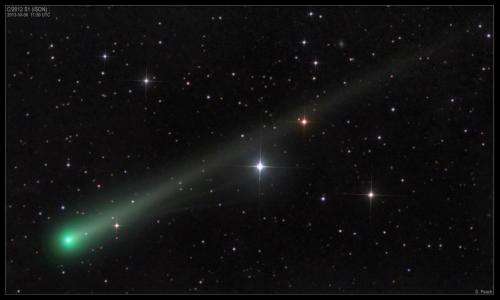NRL-developed telescopes await the approaching comet ISON

When Comet C/2012 S1 (ISON), a so-called Sungrazing comet, sweeps by the Sun on November 28, 2013, telescopes developed by the U.S. Naval Research Laboratory (NRL) will be lined up for a spectacular front row view.
The NRL-developed Sun-Earth Connection Coronal and Heliospheric Investigation (SECCHI) instrument suite aboard NASA's STEREO mission and the NRL-developed Large Angle Spectrometric and Coronagraphic Telescope (LASCO) aboard the ESA/NASA SOHO mission will be perfectly situated for a view of Comet ISON. NRL's Karl Battams explains that because of their position and capability, "SECCHI and LASCO will be unquestionably the most important telescopes for a few days on either side of ISON's closest approach to the sun on November 28. These coronagraphs will be the only telescopes in space or on Earth that will be able to continuously monitor the comet during this truly critical phase."
NRL researchers developed SECCHI and LASCO to study the Sun's corona and Coronal Mass Ejections, disruptive space weather storms that have an impact on the Earth. As an unintended side-benefit, SECCHI and LASCO telescopes also provide researchers with a wealth of comet images.
Battams, a researcher in NRL's Space Science Division, Solar and Heliospheric Physics Branch, hosts the Sungrazer Project and is also a member of the NASA Comet ISON Observing Campaign. Comet ISON is a Sungrazing comet, which means it will fly very close to the Sun, through the millions of degree solar corona. These Sungrazers can help researchers better understand both comets and the Sun. NRL took control of the Sungrazer Project ten years ago and to date, more than 2,500 new Sungrazing comets have been discovered by both professional and amateur astronomers.
Sungrazing comets are unique objects that experience the most extreme thermal and gravitation forces our solar system has to offer. However, they are rarely visible for more than a few hours before they are torn apart as they approach the Sun. Having been discovered well over a year ago, Comet ISON offers researchers the uncommon opportunity to study a Sungrazer in great detail, for an extended period, and place it in the context of other comets. Even more interesting is that Comet ISON is a dynamically new Oort Cloud comet, meaning it has never visited our solar system before and thus contains pristine early solar system material that scientists will get to observe being vaporized as ISON makes its closest approach to the Sun, just 680,000 miles above its surface, on Thanksgiving Day, Nov. 28.
Comet ISON may not survive its close encounter with the Sun. Many Sungrazing comets perish during the trip because the solar radiation boils away the ices that bind the comet together, and the gravitational pull of the Sun can rip them apart. Measurements from the Hubble and Spitzer Space Telescopes indicate the comet's nucleus is around one mile in diameter, making it a slightly smaller than average comet. However, scientists believe that this particular comet should be just about large and dense enough to survive.
If ISON does survive its dangerous passage near the sun, scientists expect that it will be naked-eye visible in the night-time sky in early December for Northern Hemisphere observers. The best time to see it will be in the morning, with the comet low on the horizon to the east-southeast. Then in early January, the comet will be visible all night long.
Comet ISON (named for the International Scientific Optical Network near Kislovodsk, Russia, which made the find) was discovered by two Russian astronomers in September 2012. At the time they first spotted the comet, ISON was still out beyond Jupiter's orbit.
Provided by Naval Research Laboratory





















